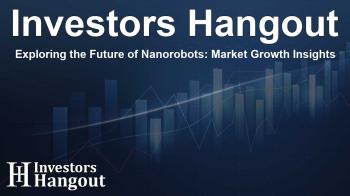Exploring the Future of Nanorobots: Market Growth Insights

Understanding the Nanorobots Market Dynamics
The global nanorobots market is on a remarkable trajectory, estimating to expand from an existing valuation of USD 9,150 million to approximately USD 38,660 million by 2034. This significant growth represents a compound annual growth rate (CAGR) of 15.5% during the period. The surge is primarily driven by the increasing integration of nanotechnology in the medical field, a greater focus on precision medicine, and ongoing innovations in molecular robotics.
What Are Nanorobots?
A Brief Overview
Nanorobotics, often referred to as nanobotics, is an innovative area in technology that develops tiny machines or robots known as nanorobots or nanobots. In the medical realm, three principal types dominate: clottocytes, microbivores, and respirocytes. These nanobots enhance treatment effectiveness through advanced biomedical procedures that require only minimally invasive techniques.
The Growth Factors Behind Nanorobots
Key Market Highlights
The nanorobots market is witnessing notable growth, with North America leading in market share as of 2024. Meanwhile, the Asia-Pacific region is anticipated to register the fastest growth rate in the coming decade. Within this scope, the microbivore nanorobots segment emerged as a leader in 2024. As research progresses, we expect cellular repair nanobots to see significant growth, introducing advanced applications in medical treatments.
According to reports, patients treated with nanorobots have shown a 78% survival rate within a year, significantly higher than the 54% survival rate observed for traditional chemotherapy patients. This difference underscores the pivotal role nanorobots play in enhancing patient outcomes.
Technological Advancements Driving Nanorobots
Integration with Advanced Technologies
Recent breakthroughs in the nanorobots market reflect vast advancements in technology. For instance, the use of micro and nanomotors facilitates precise drug delivery, effective biosensing, waste elimination, and an overall enhancement in precision healthcare. Researchers are striving to develop nanorobots capable of oncological treatments that prioritize healthy tissue, providing alternatives to traditional radiation and chemotherapy that often inflict collateral damage.
The integration of artificial intelligence is making waves in nanorobot functionality. AI enhances the navigation, control, and decision-making processes crucial for applications spanning from environmental solutions to medical interventions. Self-guiding capabilities present significant potential for improving decision outcomes in complex environments.
Market Trends and Opportunities
Investment and Research Developments
The nanorobots market benefits greatly from increased investment in research and development. Governmental and private sector funding is brisking innovation within the biotechnology and pharmaceutical industries, especially in regions like the United States and Asia-Pacific. Notably, the U.S. military is also exploring the use of nanorobots in defense applications to enhance surveillance capabilities and detect biological agents.
In late 2024, significant breakthroughs by a startup in the nanotechnology sector showcased the potential of magnetically-controlled nanobots designed for efficient dental procedures, aiming to lessen discomfort for patients significantly.
Challenges Facing Nanorobots
Bioethical Considerations
While the advancements in nanotechnology paint a bright future for the nanorobots market, they also come with challenges. Designing these intricate machines while ensuring safety remains critical. Concerns arise regarding the potential immune response the human body may exhibit toward nanorobots, perceived as foreign entities. Furthermore, addressing the toxicity associated with metal-based nanomaterials is essential as they could pose risks if ingested.
The lack of fully scaled manufacturing techniques and the need for close collaboration among experts in nanotechnology, biotechnology, artificial intelligence, and materials science are barriers that must be overcome for broader implementation.
Regional Insights
North America: The Market Leader
North America comprises a substantial share of the nanorobots market, buoyed by robust pharmaceutical industries and premier research institutions. Initiatives by organizations like the National Institute of Health and substantial expenditure on health and defense make this region fertile ground for innovation in nanotechnology.
Asia-Pacific’s Rising Significance
Asian countries, particularly Japan, China, India, and South Korea, are becoming increasingly vital players in the nanorobots market. Government initiatives in biotechnological applications illuminate the path for a new generation of healthcare solutions, focusing on large-scale and cost-effective production of nanorobots.
Frequently Asked Questions
What are nanorobots used for?
Nanorobots are primarily designed for medical applications, including targeted drug delivery, cancer treatment, and advanced therapeutic methods that require minimal invasiveness.
Why is the nanorobots market growing?
The market is expanding due to advancements in nanotechnology, increasing focus on precision medicine, and innovations in molecular robotics, leading to better patient outcomes.
What challenges do nanorobots face?
Major challenges include bioethical concerns, safety risks associated with foreign material recognition by the body, and the need for advanced manufacturing techniques.
How do nanorobots improve patient outcomes?
Nanorobots enhance treatment efficacy and reduce side effects, leading to improved survival rates compared to traditional treatments like chemotherapy.
What is the future outlook for the nanorobots market?
The market is projected to grow significantly, with an expected value of USD 38,660 million by 2034, driven by technological advancements and increased investment in research and development.
About The Author
Contact Kelly Martin privately here. Or send an email with ATTN: Kelly Martin as the subject to contact@investorshangout.com.
About Investors Hangout
Investors Hangout is a leading online stock forum for financial discussion and learning, offering a wide range of free tools and resources. It draws in traders of all levels, who exchange market knowledge, investigate trading tactics, and keep an eye on industry developments in real time. Featuring financial articles, stock message boards, quotes, charts, company profiles, and live news updates. Through cooperative learning and a wealth of informational resources, it helps users from novices creating their first portfolios to experts honing their techniques. Join Investors Hangout today: https://investorshangout.com/
The content of this article is based on factual, publicly available information and does not represent legal, financial, or investment advice. Investors Hangout does not offer financial advice, and the author is not a licensed financial advisor. Consult a qualified advisor before making any financial or investment decisions based on this article. This article should not be considered advice to purchase, sell, or hold any securities or other investments. If any of the material provided here is inaccurate, please contact us for corrections.

